Abstract
The adipocytokine resistin impairs glucose tolerance and insulin sensitivity. Here, we examine the effect of resistin on glucose uptake in human trophoblast cells and we demonstrate that transplacental glucose transport is mediated by glucose transporter (GLUT)-1. Furthermore, we evaluate the type of signal transduction induced by resistin in GLUT-1 regulation. BeWo choriocarcinoma cells and primary cytotrophoblast cells were cultured with increasing resistin concentrations for 24 hrs. The main outcome measures include glucose transport assay using [3H]-2-deoxy glucose, GLUT-1 protein expression by Western blot analysis and GLUT-1 mRNA detection by quantitative real-time RT-PCR. Quantitative determination of phospho(p)-ERK1/2 in cell lysates was performed by an Enzyme Immunometric Assay and Western blot analysis. Our data demonstrate a direct effect of resistin on normal cytotrophoblastic and on BeWo cells: resistin modulates glucose uptake, GLUT-1 messenger ribonucleic acid (mRNA) and protein expression in placental cells. We suggest that ERK1/2 phosphorylation is involved in the GLUT-1 regulation induced by resistin. In conclusion, resistin causes activation of both the ERK1 and 2 pathway in trophoblast cells. ERK1 and 2 activation stimulated GLUT-1 synthesis and resulted in increase of placental glucose uptake. High resistin levels (50–100 ng/ml) seem able to affect glucose-uptake, presumably by decreasing the cell surface glucose transporter.
Keywords: resistin, human, trophoblast, glucose
Introduction
Resistin is a novel signalling molecule induced during adipogenesis [1]. Resistin serum levels increase in obesity and resistin gene expression is induced during adipocyte differentiation. In addition, administration of resistin impaires glucose tolerance and insulin action while neutralization of resistin reduces hyperglycaemia in the mouse model of diet-induce insulin resistance [1]. Anti-resistin IgG also potentiate insulin-stimulated glucose uptake supporting the notion that resistin's effects on glucose metabolism are antagonistic to those of insulin.
Recently Yura et al. [2] demonstrated resistin gene expression in trophoblastic tissue. This expression is significantly higher in term placenta than in first trimester chorionic villi. Serum resistin levels are similar among non-pregnant women and those in the first and second trimesters of normal pregnancy, but are significantly higher in the third trimester [3]. On the other hand, resistin gene expression in adipose tissue of non-pregnant women is rather weak and does not differ from adipose tissue of pregnant women at term [3]. Based on these findings, it is reasonable to speculate that resistin production by the placenta is the main cause of the increase in serum resistin during gestation.
The increase of serum resistin in the third trimester of pregnancy may contribute, with several placental-derived hormones, to the decreased insulin sensitivity of pregnant women in the latter half of pregnancy. The decreased insulin sensitivity can be related to the development of post-prandial hyperglycaemia, benefical for the rapid growth of the foetus.
Glucose is a primary substrate for foetal energy metabolism and in the absence of appreciable gluconeogenesis [4] placental transport constitutes the only supply for the foetus. Insulin stimulates glucose uptake by recruitment of insulin-sensitive glucose trasporters (GLUTs). Among them, GLUT-1 is mainly present in the micovillous membrane and basal membrane of the syncytiotrophoblast in third trimester of gestation [5–7]. Alterations in GLUT-1 expression may result from changes in plasma glucose or insulin sensitivity in a variety of cells and tissues [8, 9]. Recent in vitro experiments suggest that resistin is able to alter glucose uptake in skeletal as well as in cardiac muscle [10], inhibiting translocation, activation of glucose transporters vesicle recycling. Exposure of 3T3L1 adipocytes to resistin impairs insulin-stimulated glucose uptake, whereas exposure to anti-resistin IgG augments glucose uptake [1]. However, no data are available about the role of resistin in human pregnancy and on placental glucose transport.
The aim of this study is to determine both the role of resistin on glucose transport in the human placenta and the type of signal transduction induced by resistin in GLUT-1 regulation. A cascade of signalling events is required for glucose uptake. At present, it is clear that activation of classical mitogen-activated protein kinase (MAPK), also termed extracellular signal-regulated kinase (ERK), plays a central role in cellular transformation, up-regulates GLUT-1 expression, thereby augmenting glucose transport [11, 12]. To understand the direct biological effect of resistin on placental glucose uptake, we treated trophoblast cells with recombinat resistin and we examined the effect on 2-3H-deoxyglucose uptake and GLUT-1 regulation. We demonstrate a direct effect of resistin in both normal cytotrophoblastic cells and on a choriocarcinoma cell line (BeWo), which is a widely used model for first trimester trophoblast. Resistin modulates glucose uptake, GLUT-1 messenger ribonucleic acid (mRNA) and protein expression in placental cells. The next question concerns which type of signal transduction, induced by resistin, is involved in GLUT-1 regulation. Previous studies have demonstrated that the activation of MAP kinases plays a pivotal role in controlling the action of resistin in several type of cells [13, 14]. Thus, we investigated the effect of resistin on MAP kinases signals in trophoblast cells. Our results suggest that the phosphorylation of ERK1/2 is probably involved in GLUT-1 regulation induced by resistin.
Materials and methods
Cell cultures
BeWo choriocarcinoma cells were obtained from the AmericanType Culture Collection (ATCC, Rockville, MD, USA). Cells were cultured in F12-K medium (ATCC), containing 10% FBS (Sigma, St. Louis, MO, USA) and 2% penicillin/streptomycin (Sigma) at 37°C in a humidified atmosphere of 5% CO2 and 95% air.
Placentas were obtained from healthy women immediately after uncomplicated vaginal delivery at 36–37 weeks of gestation. Maternal consent was obtained according to the guidelines of the ethics committee. Cytotrophoblast cells were isolated as detailed elsewhere [15]. Briefly, placental tissues were rinsed 3 times in cold Dulbecco's modified Eagle's medium (DMEM)-10% FBS (Sigma). After mincing, the tissues were submitted to repeated enzymatic digestions in Ringer-bicarbonate buffer containing 0.25% trypsin (Gibco BRL, Grand Island, NY, USA) and DNAse I (Sigma) at 37°C in a shaking water bath. The supernatants were filtered through a 42-μm mesh filter and centrifuged (200 g at room temperature for 7 min.); then the cell suspension was layered over a performed Percoll (Amersham Pharmacia, Little Chalfont, UK) gradient in Hank's balanced salt solution (HBSS; Gibco BRL). The gradient was made from 5% to 70% Percoll (v/v) by dilutions of 90% Percoll (9 parts Percoll, HBSS 10× 1 part) and layered in a 50-ml conical polystirene centrifuge tube. After centrifugation (200 g at room temperature for 20 min.), the middle layer was removed, washed and then resuspended in DMEM. Cytotrophoblast cell viability was (90% by trypan blue dye exclusion. The purity of the cell preparation was evaluated by immunohistochemical staining for markers of (i) macrophages (3%, determined using a polyclonal anti-α1-chymotrypsin antibody; Dako, Santa Barbara, CA, USA), (ii) fibroblasts (2%, determined using a polyclonal anti-vimentin antibody; Labsystems, Helsinki, Finland) and (iii) syncytiotrophoblast (1% determined using an mAb against low molecular weight cytokeratins; Labsystems, Chicago, IL, USA). The enriched (95%) cytotrophoblast cells were cultured in DMEM-10% FBS at 37°C in 5% CO2/95% air.
Bewo and cytotrophoblast cells were cultured for 24, 48 or 72 hrs in standard medium and counted to evaluate their morphological changes. Then Both BeWo and cytotrophoblast cells were cultured for 48 hrs and then treated with human recombinant Resistin (Phoenix Pharmaceutical Inc., Belmont, CA, USA) for additional 24 hrs.
Glucose transport assays
Glucose uptake was measured using [3H]-2-deoxy glucose (2-DG; Amersham Biosciences, UK). Briefly, BeWo and normal cytotrophoblast cells were seeded on plates with 24-wells (8×104 cells/well) and incubated with resistin (0, 10, 50, 100 ng/ml) for 24 hrs. Then cells were rinsed twice with glucose-free HEPES buffered saline (HBS) (140 mM NaCl, 20 mM HEPES-Na, pH 7.4, 2.5 mM MgSO4, 5 mM KCl, 1 mM CaCl2). 2DG uptake was monitored at room temperature and quantitated using 10 μM 2-DG (1 μCi/ml) for 10 min. during which period the uptake of glucose was linear. Cytochalasin B (10 μM), a potent inhibitor of glucose transport mediated via facilitative glucose transporters [16], was used as negative control. The uptake of glucose into trophoblast cells was terminated by rapidly aspirating the radioactive incubation medium, followed by three successive washes of cells monolayer with ice-cold isotonic saline solution (0.9% NaCl, w/v). Cell-associated radioactivity was determined by lysing cells with 0.05 NaOH and preparing an aliquot of the lysate for liquid scintillation counting. Total cell protein was determined by the Bradford method [17].
Western blot analysis
BeWo and cytotrophoblast cell cultures were performed for 24 hrs with resistin (0, 10, 50, 100 ng/ml). GLUT-1 expression was investigated by Western blot analysis as previously described [18]. Briefly, plasma membranes (post-nuclear particulate fraction without cytosolic components) from trophoblast cells were prepared by a procedure reported by Shah et al.[19]. Cell pellet was resuspended in 20 ml of ice-cold buffer (250 mM sucrose, 20 mM HEPES, pH 7.4, 2 mM EGTA, 3 mM NaN3) containing freshly added protease inhibitors (200 μM pheylmethylsulphonylfluoride and 1 μM leupeptin; Sigma) and homogenized in a 40 ml glass Dounce homogenizer. The homogenate was centrifuged at 700 g for 5 min. to remove nuclei and unbroken cells and the resultant supernatant was centrifuged at 236,000 ×g for 60 min. to pellet cell membranes. The membranes were resuspended in homogenising buffer and frozen at −80°C until required. Eighty μg of each sample (total membranes) were separated on a 12% SDS-polyacrylamide gel, and after electroblotting onto polyvinylidene fluoride (PVDF) membranes (Millipore, Bedford, MA, USA). The membranes were incubated with 5% non-fat dry milk in 1 mol/l Trizma/base, 1.54 mol/l NaCl, 0.05% Tween 20 (TBST, pH 7.4) and then incubated overnight at 4°C with primary antibody (anti-GLUT-1 polyclonal IgG antibody; Santa Cruz Biotecnology, Santa Cruz, CA, USA). After incubation with secondary antibody, the immunocomplexes were visualized performed with ECL-Plus detection System (Amersham) according to the instruction of the manufacturer. Bands were analysed on the image analysis system Gel Doc 200 System (Biorad Laboratories) and quantified performed with the Quantity One Quantitation Software (Biorad). The levels of GLUT-1 was estimated versus the constant level of a 53-kD protein present in total membranes (β-Tubulin; mouse monoclonal antibody; Sigma).
Moreover, in immunoblot analysis we evaluated both, total and phosphorylate ERKs (pERKs). BeWo and cytotrophoblast cells treated with resistin for 20 min. were collected and lysed with cold lysis buffer (1 mM MgCl2, 350 mM NaCl, 20 mM HEPES, 0.5 mM EDTA, 0.1 mM EGTA, 1 mM DTT, 1 mM Na4P2O7, 1 mM PMSF, 1 mM aprotinin, 1.5 mM leupeptin, 20% glycerol, 1% NP-40). Total cell proteins (80 μg) were subjected to electroforesis on 10% polyacrilamide gel and after electroblotting onto PVDF membrane incubated with 5% non-fat dry milk in TBST 1X and then exposed overnight at 4°C to TBST containing 0.2–0.4 μg/ml of primary antibody to total ERK or pERK (anti-ERK polyclonal and anti-pERK monoclonal IgG antibodies, Santa Cruz laboratories). Following incubation with secondary antibody, the immunocomplexes were visualized as described above. The levels of total or pERK were estimated versus the constant level of a 42-kD protein present in the cytosolic extract (β-actin; mouse monoclonal, Sigma-Aldrich; data not shown).
In a next set of experiments, we investigated effects of a specific inhibitor of the MAPK-pathway on phophorylation of ERK 1/2. BeWo and cytotrophoblast cells were treated with resistin (10 ng/ml) and/or ERK 1/2 kinase inhibitor (PD98059, 25 μM; Sigma) for 24 hrs and GLUT-1 expression was studied by Western blot as previously described.
Quantitative real-time RT-PCR
mRNA studies have been done both on BeWo and primary cytotrophoblast cells cultures. Total cellular RNA was extracted performed with ‘QuickPrep’ Total RNA Extraction Kit (Amersham Biosciences) according to the manufacturer's protocol. Briefly, cell pellets, obtained from BeWo and cytotrophoblast cells grown with resistin (0, 10, 50, 100 ng/ml) for 24 hr, were suspended in Lithium Chloride solution, β-mercaptoethanol and extraction buffer. Then, samples were homogenized and incubated for 10 min. in ice with Caesium Trifluoroacetate (CsTFA) solution. After centrifugation at 14,000 rpm for 15 min., RNA pellets were washed and dissolved in 50 μl of DEPC-treated water. RNA concentration was evaluated by monitoring absorbance at 260/280 nm.
Quantitative expression of the GLUT-1 gene was performed by real-time PCR using the i-Cycler iQ™ system (Bio-Rad Laboratories, Hercules, CA, USA). For the target gene and the endogenous housekeeping gene encoding for glyceraldehyde-3-phosphate dehydrogenase (GAPDH), a primer pair and Taqman probe, which hybridizes to the region between primers, were designed performed with Beacon Designer 2 v. 3.00 software (Premier Biosoft International, Palo Alto, CA, USA) and synthesized by MWG Biotech (Florence, Italy) (Table 1). Quantitative PCR was performed in a 50-μl volume containing the following reagents: 25 μl of the Platinum Quantitative RT-PCR ThermoScript reaction mix (Invitrogen Inc., Milan, Italy), 1.5 U of ThermoScript Plus/Platinum Taq mix (Invitrogen), each primer pair and Taqman probe at concentration of 0.5 μM, 5 μl of total RNA sample and distilled water up to final volume. Samples were subjected to an initial step at 52°C for 45 min. for RT; 94°C for 5 min. to inactivate the ThermoScript Plus reverse transcriptase and to activate the Platinum Taq polymerase; and 50 cycles, each consisting of 15 sec. at 94°C and 1 min. at 59°C. Fluorescent data were collected during the 59°C annealing/extension step and analysed with the iCycler iQ™ software (Bio-Rad). Each reaction was run in quadruplicate. Mean threshold cycle (Ct) was determined for each transcript and was plotted versus RNA concentration input to calculate the slope. Amplification efficiency for all genes was then determined [20, 21]. For relative quantification of the target genes, each set of primer pairs and Taqman probe were used in combination with that of GAPDH gene in separate reactions. The relative mRNA expression levels of the target genes in each sample were calculated using the comparative cycle time (Ct) method [22]. Briefly, the target PCR Ct value (i.e. the cycle number at which emitted fluorescence exceeds 10 × the standard deviation [S.D.] of baseline emissions as measured from cycles 3 to 15) is normalized to the GAPDH PCR Ct value by subtracting the GAPDH Ct value from the target PCR Ct value, which gives the ACt value. From this ACt value, the relative mRNA expression level to GAPDH for each target PCR can be calculated using the following equation: relative mRNA expression = 2-(Ct target-Ct GAPDH).
1.
Primers and fluorescent probes used in real-time PCR
| Gene | Primer or probe | Sequencea | ||
|---|---|---|---|---|
| GLUT-1 | GLUT-1a | CAGACATGGGTCCACCGCTAT | ||
| GLUT-1b | CCAGCAGGTTCATCATCAGCATT | |||
| GLUT-1pr | 6FAM-ATCCTGCCCACCACGCTCACCACG-TAMRA | |||
| GAPDH | GAPDHa | GGACCTGACCTGCCGTCTAG | ||
| GAPDHb | TAGCCCAGGATGCCCTTGAG | |||
| GAPDHpr | TexasRed-CCTCCGACGCCTGCTTCACCACCT-BHQ2 | |||
Abbreviations: 6FAM, 6-carboxyfluorescein;
TAMRA,6-carboxy-N,N,N’,N’-tetramethylrhodamine;
Texas Red, trademark product from Molecular Probes; BHQ2, Black Hole Quencer 2.
To assess the validity of GAPDH as a reference gene for comparative studies of gene expression with and without resistin treatment, an absolute quantification of GAPDH transcripts was performed. To this end, a standard curve was constructed by plotting serial dilutions of a cloned GAPDH gene fragment (range 1012 to 106 copies/reaction) and used to quantify GAPDH mRNA in samples of RNA extracted from BeWo and cytotrophoblast cells treated or not with resistin (50 ng of total RNA for each sample). The results were expressed as GAPDH copies per μg of total RNA. Similar amounts of GAPDH mRNA were found in cells grown in absence or in presence of resistin (1.2 × 1011versus 0.9 × 1011 copies/μg of RNA). This finding demonstrated that resistin does not affect GAPDH expression in BeWo choriocarcinoma cells.
Immunocytochemistry
BeWo cells were treated for 24 hrs with resistin (0, 10, 50, 100 ng/ml) and then fixed with 4% paraformaldheide (15 min. at 4°C). After washing 3 times for 5 min. each in phosphate buffer 0.01 M pH 7.6 added with NaCl 0.9% w/v (PBS) at room temperature, cells were incubated in 3% v/v Normal Donkey Serum (Jackson Immunoresearch; West Grove, PA, USA) in PBS for 30 min. at room temperature to block non-specific binding.
Afterwards cells were incubated for 60 min. at room temperature with the primary antibody against GLUT-1 (Rabbit Polyclonal RB-078-A from NeoMarkers; Fremont, CA, USA) diluted at 1:50 v/v in PBS. Cells were washed 4 times for 8 min. each and blocked again with Normal Donkey Serum.
A secondary anti-rabbit antibody (Donkey 711-096-152 from Jackson ImmunoResearch; West Grove, PA, USA) was used diluted 1:200 in PBS and cells were incubated for 30 min. in the dark at room temperature.
After numerous washings, cells were incubated with TOTO-3 iodide (642/660 from Invitrogen) diluted 1:4000 for 30 min. in the dark at room temperature to mark nuclei.
Slides were coverslipped performed with Vectashield Mounting Medium (Vector; Burlingame, CA, USA) and cells were visualized under a motorized Leica DM6000 microscope. Fluorescence was detected with a Leica TCS-SL confocal microscope.
Assay of ERK phosphorylation
Assay for ERK phosphorylation has been done both on BeWo and primary cytotrophoblast cells. ERK1/2 kinases are characterized by the requirement of phosphorylation for full activation and the quantitative determination of phospho(p)-ERK1/2 in BeWo and cytotrophoblast cell lysates was performed by an Enzyme Immunometric Assay (EIA) kit (Assay Designs, Inc., Ann Arbor, MI, USA) after treatment with resistin (0, 10, 100 ng/ml) for 10, 20, 30 and 60 min. This kit uses a monoclonal antibody to ERK immobilized on a microtitre plate to bind pERK in the standards or sample. After a short incubation, the excess sample or standard is washed out and a rabbit polyclonal antibody to pERK was added. This antibody binds to the pERK captured on the plate. After incubation, the excess antibody is washed out and goat anti-rabbit IgG conjugated to Horseradish peroxidase is added, which binds to the polyclonal pERK antibody. Excess conjugated is washed out and substrate is added. After 30 min., the enzyme reaction is stopped and the colour generated is read at 450 nm. The measured optical density is directly proportional to the concentration of pERK.
Statistical analyses
The results are presented as the mean ± S.E. The data were analysed using one-way ANOVA followed by a post hoc test (Bonferroni test). Statistical significance was determined at P < 0.05.
Results
It is known that isolated mononuclear trophoblast cells changed their morphological aspect during culture from uniformally distributed cells (24 hrs) to aggregates of two or more cells (48 hrs) and to multinucleated groups (72 hrs of culture). To formally demonstrate the in vitro formation of multinucleated cells, Bewo and cytotrophoblast cells were cultured for 24, 48 and 72 hrs, removed from the plates (by gentle trypsinization and scraping) and counted in a hemotocytometer (Table 2).
2.
Morphologic changes of cultured BeWo and cytotrophoblast cells
| BeWo | Cytotrophoblast cells | |||||||||||||||||||||||||
|---|---|---|---|---|---|---|---|---|---|---|---|---|---|---|---|---|---|---|---|---|---|---|---|---|---|---|
| Time of culture | ||||||||||||||||||||||||||
| 24 hrs | 48 hrs | 72 hrs | 24 hrs | 48 hrs | 72 hrs | |||||||||||||||||||||
| Single cells* | 82 ± 6 | 38 ± 9 | 8 ± 2 | 79 ± 7 | 38 ± 4 | 5 ± 1 | ||||||||||||||||||||
| Aggregates* | 13 ± 3 | 32 ± 5 | 12 ± 4 | 15 ± 2 | 38 ± 6 | 10 ± 2 | ||||||||||||||||||||
| Syncytia* | 5 ± 1 | 30 ± 4 | 80 ± 5 | 6 ± 1 | 24 ± 2 | 85 ± 6 | ||||||||||||||||||||
Percentage of 200 counted cells.
Effects of resistin on 2DG uptake in trophoblast cells
Uptake of 2DG in both BeWo and nomal cytotrophoblast cells was linear over the 30-min. assay period (Fig. 1). In the presence of 10-μM cytochalasin B, an inhibitor of facilitative glucose transport, 2DG uptake was suppressed by over 90% and over 78% in Bewo and cytotrophoblast cells, respectively (Fig. 1).
1.
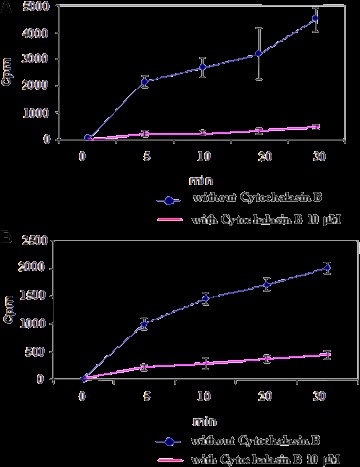
Basal glucose uptake in (A) human choriocarcinoma cells (BeWo) and in (B) human cytotrophoblast cells. Glucose uptake was measured using [3H]-2-deoxy glucose for 30 min. Cytochalasin B (10 μM), a potent inhibitor of glucose transport, was used as negative control. Values are means ± S.E. of three different experiments.
As shown in Figure 2, treatment with resistin (10 ng/ml, concentration that is reached in vivo) for 24 hrs led to a stimulation of 2-DG uptake, while higher concentrations (50–100 ng/ml) significantly impaired basal glucose uptake.
2.
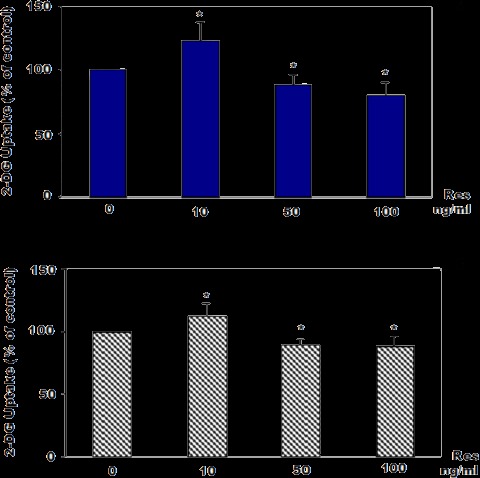
Effect of resistin (0–100 ng/ml) on glucose uptake in BeWo cells (A) and in human cytotrophoblast cells (B). Glucose uptake was measured using 10 μJM [3H]-2-deoxy glucose (1 μCi/ml) for 10 min. Data are expressed as percentage of untreated cells (resistin 0 ng/ml; controls): *P < 0.05; Res: resistin.
GLUT-1 expression in trophoblast cells
To study whether the effects of resistin on basal glucose uptake were due to the regulation of GLUT-1 expression, we analysed the changes in GLUT- 1 protein and mRNA levels.
Western blotting analysis showed that there was a significant increase of GLUT-1 expression after incubation with resistin at dose of 10 ng/ml, whereas starting from 50 ng/ml there was a reduction of protein expression (Fig. 3). The mRNA for GLUT-1 was quantified by real-time RT-PCR. We observed constitutive expression of GLUT-1 mRNA in Bewo and cytotrophoblast cells. The intensity of GLUT-1 mRNA was normalized with the internal control, the GAPDH gene. As shown in Figure 4 (A and B), GLUT-1 mRNA was increased after treatment with resistin at dose of 10 ng/ml, but when BeWo cells were exposed to higher concentrations of resistin (50–100 ng/ml) a significant reduction in GLUT-1 mRNA was observed.
3.
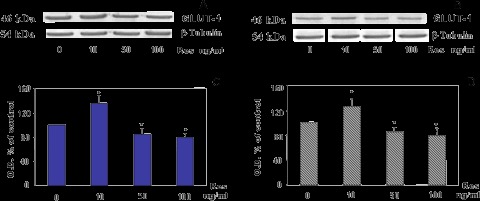
Analysis of GLUT-1 expression in plasma membranes of BeWo and cytotrophoblast cells treated with resistin (0–100 ng/ml) for 24 hrs. A representative experiment of Western blot analyses (GLUT-1 protein and (β-tubulin) in BeWo (A) and normal cytotrophoblast cells (B). Results of densitometric analyses. The level of GLUT-1 in BeWo (C) and normal cytotrophoblast cells (D) was estimated in comparison with the constant level of (β-tubulin and expressed as a percentage of the control (0 ng/ml resistin = 100%). Results are means ± S.E. of six independent experiments. Significance versus untreated cells: *P < 0.05; O.D.: optical density; Res: resistin.
4.
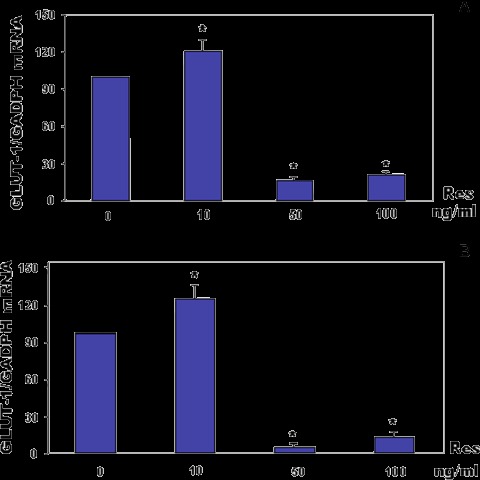
Quantitative mRNA expression of GLUT-1 in BeWo (A) and cytotrophoblast cells (B) treated with resistin (0–100 ng/ml). Total RNA was extracted and levels of GLUT-1 mRNA were measured by Real-time PCR. Data shown are means ± S.E. of three independent experiments. The results are presented as the fold increase of mRNA expression with normalization to GAPDH. Res: resistin.
Immunocytochemistry
Immunocytochemistry of BeWo cells treated and non-treated with resistin showed a reaction product characterized by microspots-like appearance. The reaction product was mainly localized at the level of the plasma membranes.
It was possible to observe an increase in GLUT-1 expression in cells treated with 10 ng/ml of resistin in comparison to non-treated cells (Fig. 5), whereas it was difficult to appreciate an evident difference in GLUT-1 expression between cells treated with 10 ng/ml and those treated with 50 ng/ml (data not shown).
5.
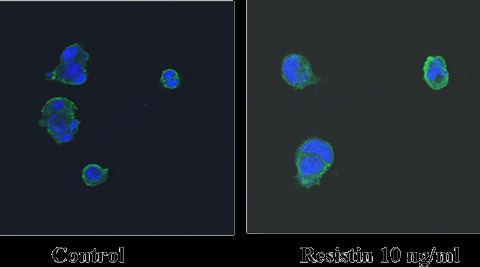
Analysis of GLUT-1 expression by confocal microscopy in BeWo cells treated (10 ng/ml) and non-treated (control) with resistin. The analysis revealed Glut-1 localization in plasma membrane with a microspots-like appearance. An increase of Glut-1 expression is observed in treated cells in comparison to non-treated cells.
Resistin-activated ERK 1/2 phosphorylation
To better understand the molecular mechanisms in resistin-induced GLUT-1 trophoblast regulation, we investigated the possible involvement of MAP Kinases. MAP activation results in phosphorylation of multifunctional protein kinases, including ERKs. The EIA assay of ERK activity showed the maximal increase of ERK 1/2 phosphorylation in Bewo cells treated with resistin (10 ng/ml) after 20 min. (4.7 ng/mg of proteins/10 −5versus control 3.2 ng/mg of proteins/10−5, P< 0.01) with a decrease at 60 min. (3.3 ng/mg of proteins/10−5versus control 3.0 ng/mg of proteins/10−5) (Fig. 6). Treatment of normal cytotrophoblast cells with resistin (10 ng/ml) led to phosphorylation of ERK1 and ERK2, with a maximal increase at 30 min. ERK1 and ERK2 phosphorylation returned towards baseline at approximately 60 min. (data not shown).
6.
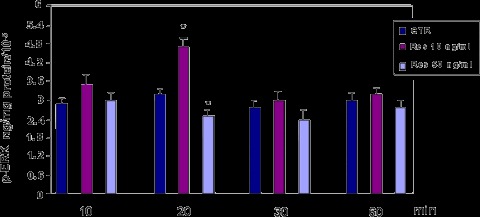
Time-dependent effect of resistin (0–50 ng/ml) on phosphorylation of ERK1/2 protein in BeWo cells. Cell extracts were analysed for the levels of p-ERK by immunoenzymatic assay as described in Materials and Methods. Results are expressed as ng/mg of protein. Values are means ± S.E. of three separate experiments with triplicate determinations. Significance versus untreated cells (control; CTR: resistin 0 ng/ml): *P < 0.05; Res: resistin.
The Western blot analysis of dose-response experiments showed the increase in ERK1/2 phosphorylation after 20 or 30 min. (Fig. 7) only at 10 ng/ml of resistin. As shown in Figure 7, total ERK1 and ERK2 expressions were not affected by resistin treatment, suggesting a specific role of this adipokine in the regulation of phosphorylation process. Similar results were obtained with normal cytotrophoblast cells (data not shown).
7.
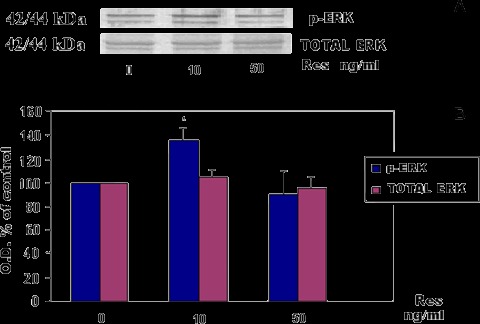
Western blot analysis of phosphorylated and total ERK expression in BeWo treated with resistin (0–50 ng/ml) for 20 min. (A) A representative Western blot analysis for phosphorylated and total ERK in BeWo cells. (B) Densitometric analysis. The level of total and p- ERK protein after resistin treatment was estimated in comparison with the constant level of (β-actin and expressed as a percentage of the control (untreated cells = 100%). Results are means ± S.E. of five independent experiments. Significance versus untreated cells (control: resistin 0 ng/ml): *P < 0.05; Res: resistin.
To clarify whether ERK blockage in BeWo and nor392mal cytotrophoblast cells is involved in resistin-induced GLUT-1 expression, trophoblast cells were incubated with a well-defined ERK kinase inhibitor: PD98059. As shown in Figure 8, PD98059 (25 μg/ml) significantly reduced the resistin-induced GLUT-1 expression.
8.
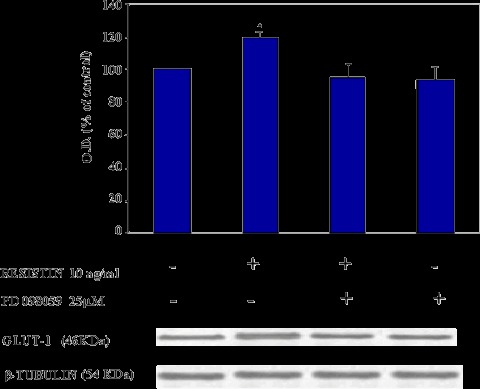
Effect of ERK1/2 inhibitor on resistin-induced GLUT-1 proliferation. A representative experiment of Western blot analyses and densitometric analysis of GLUT-1 expression in plasma membranes of BeWo cells treated with resistin (10 ng/ml) and/or ERK 1/2 kinase inhibitor (PD98059; 25 μM) for 24 hrs. The levels of GLUT-1 in BeWo cells were estimated in comparison with the constant level of (β-tubulin and expressed as a percentage of the control (CTR: 0 ng/ml resistin = 100%). Results are means ± S.E. of six independent experiments. Significance versus untreated cells: *P < 0.05; O.D.: optical density.
Discussion
Recently, Yura et al.[2] demonstrated resistin gene expression in trophoblastic tissue, which was significantly higher in term placenta as compared with that in the chorionic villi of the first trimester. These findings suggested the possibility that the placenta might secrete resistin into the maternal circulation. In fact, plasma resistin levels of pregnant women at term were significantly higher than those of non-pregnant women [3], whereas plasma resistin levels of non-pregnant women were similar to those of the first and second trimesters of normal pregnancy. However, the exact mechanisms behind the increase in serum resistin during pregnancy have not been clarified. Based on Yura's results [2] and the fact that there is an increase in placental mass with gestation, it is reasonable to speculate that resistin production by the placenta is the main cause of the increase in serum level resistin. On the other hand, considering that the adipose tissue mass increases during pregnancy and that the expression of resistin in adipose tissue of pregnant women at term does not differ from that of non-pregnant women [23], resistin production by adipose tissue might be one of the causes for the increased serum resistin level in pregnancy. Such changes in resistin levels could contribute to the decrease insulin sensitivity in the latter half of pregnancy [24] beneficial for the rapid growth of the foetus.
Glucose is the primary substrate for foetal energy metabolism and in the absence of appreciable gluconeogenesis [25], placental transport constitues the only supply for the foetus. Glucose transport across the human placenta takes place by facilitated carrier-mediated diffusion [26, 27]. The kinetic characteristics of glucose transport have been determined in human syncytiotrophoblast cell membranes [28, 29] and are consistent with the presence of high-capacity transport systems in both the maternal and foetal-facing plasma membranes with affinities in the 25–30 mmol/l range.
Northern blotting has been used to identify human tissues expressing the facilitative glucose transporter isoforms: GLUT1 and GLUT3 have been shown to be present in high levels in homogenates of human term placenta [30, 31]. However, a quantitative estimate of the glucose transporter proteins demonstrated the absence of significant amounts of GLUT3 protein and the presence of GLUT-1 protein in human syncytiotrophoblast [32]. Immunohistochemical data have demonstrated that GLUT-1 protein is abundant on both the microvillous and basal membrane of the syncytiotrophoblast [33]. We confirmed these observations and we demonstrated the presence of GLUT-1 protein, the main glucose trasporter in human trophoblast [32]. Basal levels of GLUT-1 mRNA expression were also regulated by resistin and the observed discordance between mRNA and protein might suggest that trophoblast cells must have a mechanism for post-transcripional regulation of GLUT-1 expression.
The present study provides the first evidence that resistin can modulate trophoblast glucose utilization. The effects of resistin on glucose transport are significant and related to the cytokine concentrations. Resistin at concentrations that are reached in vivo (10 ng/ml) [34] enhanced glucose uptake, while higher concentrations (50–100 ng/ml) significantly impair trophoblast glucose uptake. The increase or decrease in glucose uptake, together with the changes in plasma membranes GLUT-1 protein expression, suggests that resistin action on glucose transport occurs through this transporter.
In the present study, we used cytotrophoblast cells obtained from human placentas. The presence of macrophages (3%) in this culture might result in enhanced secretion of resistin-induced proinflammatory cytokines, TNF-α and IL-12, involved in obesity and diabetes [35]. These cytokines might influence the resistin response of trophoblast cells, however, the semi-purified culture might reflect the in vivo condition better than highly purified cells.
In vitro experiments have suggested that exposure of 3T3L1 adipocytes to resistin impairs insulin-stimulated glucose uptake, whereas exposure to anti-resistin IgG augments glucose uptake [36] by mechanisms involving the regulation of suppressor of cytokine signalling-3 (SOCS-3) [37]. Recently Gravelau et al.[38] demonstrated that resistin causes a significant reduction in insulin-stimulated glucose uptake impairing glucose transporter translocation in human cardiomyocytes. From these data, human resistin seems able to impair insulin action in insulin responsive cells in vitro, but no data are available on a possible direct effect of resistin in the same cells.
Transgenic mice that overexpress the resistin gene (Retn) in adipose tissue are insulin resistant, whereas Retn (−/−) mice show lower fasting blood glucose, suggesting that high resistin concentrations might be related to diabetes [39]. Then increased levels of resistin in human beings could potentially impair insulin sensitivity in vivo and contribute to the association between hyper-resistinemia, glucose intolerance and type 2 diabetes [39]. The plasma concentrations of resistin in patients with insulin resistance remain to be carefully defined, although preliminary studies suggest that mean circulating resistin levels may be 40 ng/ml in diabetes versus 15 ng/ml in lean non-diabetic patients [34, 40]. Also during pregnancy, hyper-resistinemia seems to be associated with the pregnancy-induced insulin resistance [41] but studies on trophoblast cells are currently lacking. We showed that resistin at high concentrations (50 ng/ml) is able to impair trophoblast glucose transport and this might represent one mechanism of the resistin-induced insulin resistance.
Although the molecular events by which resistin may regulate trophoblast glucose uptake are not clear, a potential model has been suggested. In particular, ERK1 and ERK2 seem to play a pivotal role in controlling GLUT-1 expression on trophoblast membranes.
Inhibition of ERK 1/2 kinase after treatment of trophoblast cells with PD98059 supports involvement of MAP-kinase pathway in resistin-induced GLUT-1 expression.
In conclusion, we have demonstrated that resistin, a novel adipokine, causes activation of both the ERK1 and 2 pathway in trophoblast cells. ERK1 and 2 activation stimulates GLUT-1 synthesis and results in an increase of placental glucose uptake. High resistin levels (50–100 ng/ml) seem to impair GLUT-1 expression and glucose uptake, reflecting a complex interaction of this adipocytokine with placental functions. However, further studies are required to delineate the role of this cytokine in human pregnancy.
Acknowledgments
This work was supported by an MIUR grant (COFIN PRIN 2002, prot. 2002067124) and a research grant from Catholic University of Sacred Hearth (D1, 2006), Rome, Italy.
References
- 1.Steppan CM, Bailey ST, Bhat S, Brown EJ, Banerjee RR, Wright CM, Patel HR, Ahima RS, Lazar MA. The hormone resistin links obesity to diabetes. Nature. 2001;409:307–12. doi: 10.1038/35053000. [DOI] [PubMed] [Google Scholar]
- 2.Yura S, Sagawa N, Itoh H, Kakui K, Nuamah MA, Korita D, Takemura M, Fujii S. Resistin is expressed in the human placenta. J Clin End Metab. 2003;88:1394–7. doi: 10.1210/jc.2002-011926. [DOI] [PubMed] [Google Scholar]
- 3.Chen D, Dong M, Fang Q, He J, Wang Z, Yang X. Alterations of serum resistin in normal pregnancy and pre-eclampsia. Clin Sci. 2005;108:81–4. doi: 10.1042/CS20040225. [DOI] [PubMed] [Google Scholar]
- 4.Gabbe SG. Gestational diabetes mellitus. N Engl J Med. 1986;315:1025–6. doi: 10.1056/NEJM198610163151609. [DOI] [PubMed] [Google Scholar]
- 5.Ericsson A, Hamark B, Powell TL, Jansson T. Glucose transporter isoform 4 is expressed in the syncytiotrophoblast of first trimester human placenta. Human Reprod. 2005;20:521–30. doi: 10.1093/humrep/deh596. [DOI] [PubMed] [Google Scholar]
- 6.Jansson T, Wennergren M, Illsley NP. Glucose transporter expression and distribution in the human placenta throughout gestation and intrauterine growth retardation. J Clin End Metab. 1993;77:1554–62. doi: 10.1210/jcem.77.6.8263141. [DOI] [PubMed] [Google Scholar]
- 7.Barros LF, Yudilevich DL, Jarvis SM, Beaumont N, Baldwin SA. Quantitation and immunolocalization of glucose transporters in the human placenta. Placenta. 1995;16:623–33. doi: 10.1016/0143-4004(95)90031-4. [DOI] [PubMed] [Google Scholar]
- 8.Mayor P, Maianu L, Garvey WT. Glucose and insulin chronically regulate insulin action via different mechanisms in BC3H1 myocytes. Diabetes. 1992;41:274–85. doi: 10.2337/diab.41.3.274. [DOI] [PubMed] [Google Scholar]
- 9.Zheng Q, Levitsky LL, Mink K, Rhoads DB. Glucose regulation of glucose transporters in cultured adult and fetal hepato-cytes. Metabolism. 1995;44:1553–8. doi: 10.1016/0026-0495(95)90074-8. [DOI] [PubMed] [Google Scholar]
- 10.Graveleau C, Zaha VG, Mohajer A, Banerjee RR, Dudley-Rucker N, Steppan CM, Rajala MW, Scherer PE, Ahima RS, Mitchell AL, Abel ED. Mouse and human resistins impair glucose transport in primary mouse cardiomyocytes, and oligomerization is required for this biological action. J Biol Chem. 2005;280:31679–85. doi: 10.1074/jbc.M504008200. [DOI] [PubMed] [Google Scholar]
- 11.Fujishiro M, Gotoh Y, Katagiri H, Sakoda H, Ogihara T, Anai M, Onishi Y, Ono H, Funaki M, Inukai K, Fukushima Y, Kikuchi M, Oka Y, Asano T. MKK6/3 and p38 MAPK pathway activation is not necessary for insulin-induced glucose uptake but regulates glucose transporter expression. J Biol Chem. 2001;276:19800–6. doi: 10.1074/jbc.M101087200. [DOI] [PubMed] [Google Scholar]
- 12.Barry JS, Davidsen ML, Limesand SW, Galan HL, Friedman JE, Regnault RH, Hay WW., Jr Developmental changes in ovine myocardial glucose transporters and insulin signaling following hyperthermia-induced intrauterine fetal growth restriction. Exp Biol Med. 2006;231:566–75. doi: 10.1177/153537020623100511. [DOI] [PubMed] [Google Scholar]
- 13.Mu H, Ohashi R, Yan S, Chai H, Yang H, Lin P, Yao Q, Chen C. Adipokine resistin promotes in vitro angiogenesis of human endothelial cells. Cardiovasc Res. 2006;70:146–57. doi: 10.1016/j.cardiores.2006.01.015. [DOI] [PubMed] [Google Scholar]
- 14.Kushiyama A, Shojima N, Ogihara T, Inukai K, Sakoda H, Fujishiro M, Fukushima Y, Anai M, Ono H, Horike N, Viana AY, Uchijima Y, Nishiyama K, Shimosawa T, Fujita T, Katagiri H, Oka Y, Kurihara H, Asano T. Resistin – like molecule beta activates MAPKs, suppresses insulin signaling in hapatocytes, and induces diabetes, hyperlipidemia, and fatty liver in transgenic mice on high fat diet. J Biol Chem. 2005;208:42016–25. doi: 10.1074/jbc.M503065200. [DOI] [PubMed] [Google Scholar]
- 15.Kliman HJ, Nestler JE, Sermasi E, Sanger JM, Strauss JF. Purification, characterization and in vitro differentiation of cytotrophoblasts from human term placentae. Endocrinology. 1986;118:1567–82. doi: 10.1210/endo-118-4-1567. [DOI] [PubMed] [Google Scholar]
- 16.Landau BR, Spring-Robinson CL, Muzic RF, Rachdaoui N, Rubin D, Berridge MS, Schumann W, Chandramouli V, Kern TS, Ismail-Beigi F. 6-fluoro-6-deoxy-D-glucose as a tracer of glucose transport. Am J Physiol Endocrinol Metab. 2007;293:E237–45. doi: 10.1152/ajpendo.00022.2007. [DOI] [PubMed] [Google Scholar]
- 17.Bredford MM. Rapid and sensitive method for the quantitation of microgram quantities of proteins utilizing the principal of protein-dye binding. Anal Biochem. 1976;72:248–54. doi: 10.1016/0003-2697(76)90527-3. [DOI] [PubMed] [Google Scholar]
- 18.Di Simone N, Maggiano N, Caliandro D, Riccardi P, Evangelista A, Carducci B, Caruso A. Homocysteine induces tro-phoblast cell death with apoptotic features. Biol Reprod. 2003;69:1129–34. doi: 10.1095/biolreprod.103.015800. [DOI] [PubMed] [Google Scholar]
- 19.Shah SW, Zhao H, Low SY, McArdle HJ, Hundal HS. Characterization of glucose transport and glucose transporters in the human choriocarcinoma cell line BeWo. Placenta. 1999;20:651–9. doi: 10.1053/plac.1999.0437. [DOI] [PubMed] [Google Scholar]
- 20.Peirson SN, Butler JN, Foster RG. Experimental validation of novel and conventional approaches to quantitative realtime PCR data analysis. Nucleic Acids Research. 2003;31:73. doi: 10.1093/nar/gng073. [DOI] [PMC free article] [PubMed] [Google Scholar]
- 21.Pfaffl MW. A new mathematical model for relative quantification in real-time RT-PCR. Nucleic Acids Res. 2001;29:45. doi: 10.1093/nar/29.9.e45. [DOI] [PMC free article] [PubMed] [Google Scholar]
- 22.Meijerink J, Mandigers C, van de Locht L, Tonnissen E, Goodsaid F, Raemaekers J. A novel method to compensate for different amplification efficiencies between patient DNA samples in quantitative realtime PCR. J Mol Diagn. 2001;3:55–61. doi: 10.1016/S1525-1578(10)60652-6. [DOI] [PMC free article] [PubMed] [Google Scholar]
- 23.Sagawa N, Yura S, Itoh H, Mise H, Kakui K, Korita D, Takemura M, Nuamah MA, Ogawa Y, Masuzaki H, Nakao K, Fujii S. Role of leptin in pregnancy: a review. Placenta. 2002;23:S80–6. doi: 10.1053/plac.2002.0814. [DOI] [PubMed] [Google Scholar]
- 24.Cortelazzi D, Corbetta S, Ronzoni S, Pelle F, Marconi A, Cozzi V, Cetin I, Cortelazzi R, Beck-Peccoz P, Spada A. Maternal and foetal resistin and adiponectin concentrations in normal and complicated pregnancies. Clin Endocrinol. 2007;66:447–53. doi: 10.1111/j.1365-2265.2007.02761.x. [DOI] [PubMed] [Google Scholar]
- 25.Jones CT, Rolph TP. Metabolism durinf fetal life: a functional assessment of metabolic development. Physiol Rev. 1985;65:357–430. doi: 10.1152/physrev.1985.65.2.357. [DOI] [PubMed] [Google Scholar]
- 26.Carstensen M, Leichtweiss HP, Molsen G, Schroder H. Evidence of a specific transport of D-hexoses across the human term placenta in vitro. Arch Gynaekol. 1977;222:187–96. doi: 10.1007/BF00717597. [DOI] [PubMed] [Google Scholar]
- 27.Schneider H, Challier JC, Dancis J. Transfer and metabolism of glucose and lactate in the human placenta studied by a perfusion system in vitro. Placenta. 1981;2:129–38. [Google Scholar]
- 28.Johnson LW, Smith CH. Monosacharide transport across microvillous membrane of human placenta. Am J Physiol. 1980;238:C160–8. doi: 10.1152/ajpcell.1980.238.5.C160. [DOI] [PubMed] [Google Scholar]
- 29.Johnson LW, Smith CH. Glucose transport across basal plasma membrane of human placental syncytiotrophoblast. Biochem Biophys Acta. 1985;815:44–50. doi: 10.1016/0005-2736(85)90472-9. [DOI] [PubMed] [Google Scholar]
- 30.Bell GI, Kayano T, Buse JB, Burant CF, Takeda J, Lin D, Fukumoto H, Seino S. Molecular biology of mammalian glucose transporters. Diabetes Care. 1990;13:198–208. doi: 10.2337/diacare.13.3.198. [DOI] [PubMed] [Google Scholar]
- 31.Devaskar SU, Mueckler MM. The mammalian glucose transportes. Pediatr Res. 1992;31:1–13. doi: 10.1203/00006450-199201000-00001. [DOI] [PubMed] [Google Scholar]
- 32.Jansson T, Cowley EA, Illsley NP. Cellular localization of glucose transporter messenger RNA in human placenta. Reprod Fertil Dev. 1995;7:1425–30. doi: 10.1071/rd9951425. [DOI] [PubMed] [Google Scholar]
- 33.Palik E, Baranyi E, Melczer Z, Audikovszky M, Szocs A, Winkler G, Cseh K. Elevated serum acylated (biologically active) ghrelin and resistin levels associate with pregnancy-induced weight gain and insulin resistance. Diabetes Res Clin Pract. 2007;76:351–7. doi: 10.1016/j.diabres.2006.09.005. [DOI] [PubMed] [Google Scholar]
- 34.Takada K, Kasahara T, Kasahara M, Ezaki O, Hirano H. Localization of erythrocyte/hep G2-type glucose transpoter (GLUT 1) in human placental villi. Cell Tissue Res. 1992;267:407–12. doi: 10.1007/BF00319362. [DOI] [PubMed] [Google Scholar]
- 35.Silswal N, Singh AK, Mukhopadhyay S, Ghosh S, Ehtesham NZ. Human resistin stimulates the pro-inflammatory cytokines TNF-alpha and IL-12 in macrophages by NF-kappa B-dependent pathway. Biochem Biophys Res Commun. 2005;334:1092–101. doi: 10.1016/j.bbrc.2005.06.202. [DOI] [PubMed] [Google Scholar]
- 36.Steppan CM, Bailey ST, Bhat S, Brown EJ, Banerjee RR, Wright CM, Patel HR, Ahima RS, Lazar MA. The hormone resistin links obesity to diabetes. Nature. 2001;409:307–12. doi: 10.1038/35053000. [DOI] [PubMed] [Google Scholar]
- 37.Steppan CM, Wang J, Whiteman EL, Birnbaum MJ, Lazar MA. Activation of SOCS-3 by resistin. Mol Cell Biol. 2005;25:1569–75. doi: 10.1128/MCB.25.4.1569-1575.2005. [DOI] [PMC free article] [PubMed] [Google Scholar]
- 38.Gravelau C, Zaha VG, Mohajer A, Banerjee RR, Dudley-Rucher N, Steppan CM, Rajala MW, Scherer PE, Ahima RS, Lazar MA, Abel ED. Mouse and human resistin impair glucose transport in primary mouse cardiomiocytes and oligomrization is required for this biological action. J Biol Chem. 2005;1:31679–85. doi: 10.1074/jbc.M504008200. [DOI] [PubMed] [Google Scholar]
- 39.Osawa H, Yamada K, Onuma H, Murakami A, Ochi M, Kawata H, Nishimiya T, Niiya T, Shimizu I, Nishida W, Hashiramoto M, Kanatsuka A, Fujii Y, Ohashi J, Makino H. The G/G genotype of a resistin single-nucleotide polymorphism at –420 increases type II diabetes mellitus susceptibility by inducing promoter activity through specific binding of SP1/3. Am J Hum Genet. 2004;75:678–86. doi: 10.1086/424761. [DOI] [PMC free article] [PubMed] [Google Scholar]
- 40.Stejskal D, Proskova J, Adamovska S, Juràkovà R, Bartek J. Preliminary experience with resistin assessment in common population. Biomed Pap Med Fac Univ Palacky Olomaouc Czech Repub. 2002;146:47–9. doi: 10.5507/bp.2002.009. [DOI] [PubMed] [Google Scholar]
- 41.Fehmann HC, Heyn J. Plasma resistin levels in patients with type 1 and type 2 diabetes mellitus and in healthy controls. Horm Metab Res. 2002;34:671–3. doi: 10.1055/s-2002-38241. [DOI] [PubMed] [Google Scholar]


